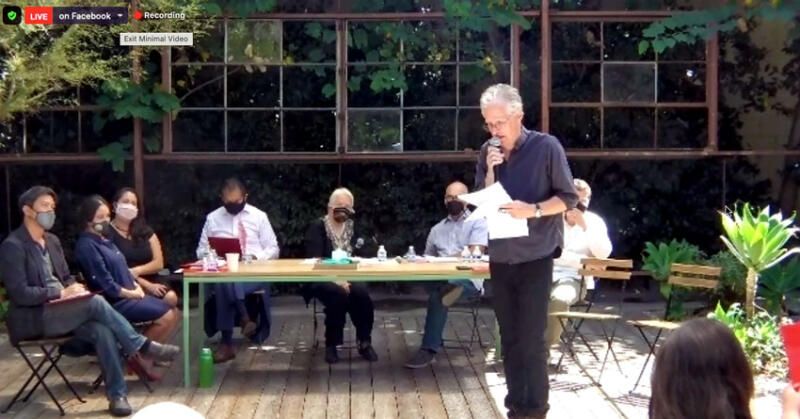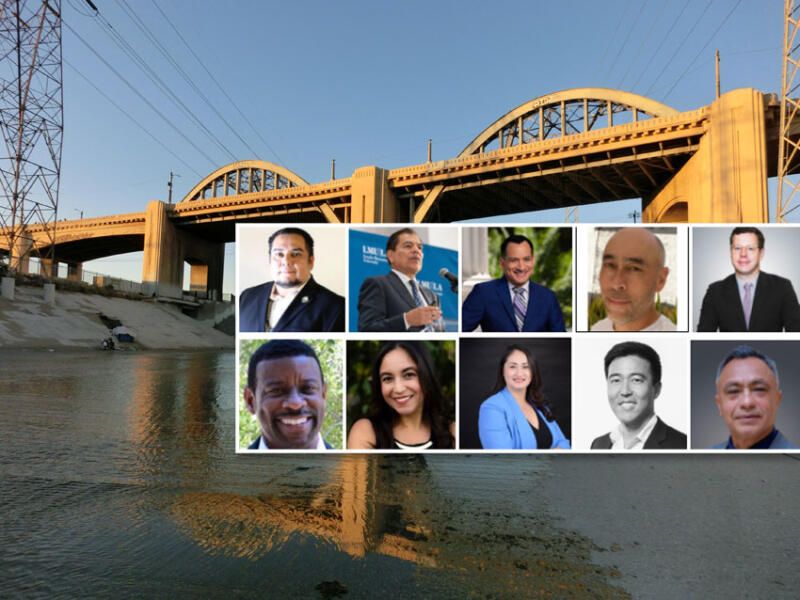Tackle Present Learning from the Past – Plans for the Future of Los Angeles River
(Above, background): The Los Angeles River in its current state. (Shutterstock) (Inset: Clockwise from top left): Rudy Ortega, Jr.,Tribal President, Fernandeno Tataviam Band of Mission Indians; Fernando Guerra, Founding Director of the Center for the Study of Los Angeles, Loyola Marymount University; Anthony Rendon, Speaker, California State Assembly; Tensho Takemori, Partner, Gehry Partners; Max Podemski, Planning Director, LA City Council President Nury Martinez; Miguel Angel Luna, President, Urban Semillas; Damon Nagami, Senior Attorney and Director, Natural Resources Defense Council’s Southern California Ecosystems Project; Belen Bernal, Executive Director, Nature for All; Sarah Rascon, Environmental Equity Officer and Urban River Program Officer, Mountains Recreation and Conservation Authority; Mark Stanley, Executive Officer, Rivers and Mountains Conservancy. (Siliconeer/EMS)
Speaking from Clockshop/Elysian in Los Angeles on the banks of the Los Angeles River, Sandy Close, director of Ethnic Media Services said, “The River, all 51 miles of it, is our star attraction. Stakeholders are working to turn a decades-long dream of revitalizing the river into reality.” The first multilingual poll of what residents of Los Angeles County think about the River conducted by noted pollster Fernando Guerra and his colleague Brianne Gilbert at LMU’s Center for the Study of Los Angeles, was also released on the occasion.
“We have not commissioned a multilingual poll since 2016, and today I would like to dedicate the poll to the memory of Sergio Bendixen, a pioneering pollster in multiple languages who did so much to project diverse voices into the public forum. Sergio died in 2016,” said Close.
Joining Sandy Close as cohosts were Jon Christensen, TK, EMS colleagues Julian Do and Pilar Marrero, Gabriel Lerner, who’s helped shepherd the LA River initiative from the start; and Regina Brown Wilson, Executive Director of California Black Media.
A special thanks was also called out to Resources Legacy fund and Alfredo Gonzalez for their support.
Speakers at this online/in-person briefing, Sept. 10, were – Rudy Ortega, Jr.,Tribal President, Fernandeno Tataviam Band of Mission Indians; Fernando Guerra, Founding Director of the Center for the Study of Los Angeles, Loyola Marymount University; Anthony Rendon, Speaker, California State Assembly; Tensho Takemori, Partner, Gehry Partners; Max Podemski, Planning Director, LA City Council President Nury Martinez; Miguel Angel Luna, President, Urban Semillas; Damon Nagami, Senior Attorney and Director, Natural Resources Defense Council’s Southern California Ecosystems Project; Belen Bernal, Executive Director, Nature for All; Sarah Rascon, Environmental Equity Officer and Urban River Program Officer, Mountains Recreation and Conservation Authority; and Mark Stanley, Executive Officer, Rivers and Mountains Conservancy.
The briefing opened with words from Rudy Ortega, Jr., Tribal President of the Fernandeno Tataviam Band of Mission Indians, in recognition of the original people who lived along the river’s banks. Fernando Guerra then shared the results of the poll, followed by a talk from a panel of stakeholders moderated by Jon Christensen of UCLA’s Laboratory for Environmental Narrative Strategies.
“It as a resource for us and it was always a life for us,” said Ortega as he acknowledged the people of his tribe. He began his opening remarks with a song in his native language.
“What we want to do is make this river even more accessible to more Angelinos especially when we start thinking and reimagining what a post-pandemic city is going to look like. The river should be up front because we need to be outside, we need to have activities that are part of this new post-pandemic urban space,” said Guerra.

The multilingual poll, held between July 7 to July 19, was a survey of 600 representative samples in LA County.
The respondents were asked a range of questions and the error margin was of about four percent. Close to one fourth of Angelinos were not aware of the river.
Survey respondents said creating habitat for plants and animals and capturing stormwater for future use before it gets to the ocean should be a high priority, as well as flood control, ensuring that residents are not displaced by new developments, making the river accessible, building more parks, and recreation on the river.
Residents have concerns about revitalization efforts, too. A majority is concerned that revitalization efforts will lead to an increase in homeless encampments along the river, increased taxes, and gentrification that will displace current residents. Low-income residents and renters are especially concerned about gentrification and displacement.
Moderator Jon Christensen introduced Anthony Rendon, Speaker, California State Assembly – “I think my experiences with the river are similar to the experiences that a lot of Angelinos have had as a child. It was always something that you sort of went past either on the bus or in a car. Sometimes rode your bike past, you didn’t really think much about it.”
“(The River) could better rather than being an open wound, a border between communities. It can actually be a bridge and bring communities together,” said Rendon.
Max Podemski, Planning Director, LA City Council President Nury Martinez, said, “It’s important that we broaden the vision of the LA River. Only river along the 51 miles
is very ambitious, but if we look at all the tributaries throughout the county, it touches basically every community and a lot of those communities are low-income communities of color that really need this open space.”
“It presents a challenge in terms of master plans because master plans are sort of imposing,” pointed Podemski.
Sarah Rascon, Environmental Equity Officer and Urban River Program Officer, Mountains Recreation and Conservation Authority, “Like many families my family prioritized working, bills, putting food on the table, and we didn’t know that we were part of environmental consciousness, but we were doing it right. It was don’t run the water because the water bill is going to be high.
“A tour helped me understand the history right. The river has gone through so many different phases of life from its origins when our tribal ancestors cared for the river and only took what they needed. LA got very densely populated, and we had other assemblers come. The river was then channelized because we built too closely to it. It’s gone through a lot.
Mark Stanley, Executive Officer, Rivers and Mountains Conservancy, said, “We need to look at it in a multiple of ways.
“How do we look at increased mobility, provide better access, the encampment issues, housing, and integrate that into Open Space?
“How do you look at the communities that want to create greater economic development and integrate that in, without creating displacement and gentrification, so those who live along the corridor today can continue to benefit?” pointed Stanley.
Belen Bernal, Executive Director, Nature for All, said, “It’s really important to look at history and learn, to re-imagine a space that unfortunately, is concrete. I don’t want to think of that next child that’s born, that they’re going to have 10 years less of life just because they grew up in an area that is heavily polluted.
“While on council, we took into account, different efforts like the urban orchard, that’s really taking advantage of county efforts Measure W.
“Hopefully, in the near future, we need to really be strategic on how we can combine
those resources to really make a true difference so that obesity levels, asthma levels, heart disease are not impacting the communities the way they are today,” said Bernal.
Damon Nagami, Senior Attorney and Director, Natural Resources Defense Council’s Southern California Ecosystems Project, said, “I see this as a real turning point for the LA River.
“To have a gathering place for Angelinos was something a lot of folks had in mind when they were envisioning what river restoration could be.
“In the middle of all that excitement there’s also concerns. We have some really important choices to make, river restoration is really important, but turning that dream into reality can come with some real concerns and problems. There are real resources, 45 million dollars for Southeast Los Angeles, that is unthinkable and a dream that’s really becoming reality just in the last few years, it’s amazing.
“It also introduces the concepts like land speculation and folks trying to cash in on public benefits in a way that might not benefit the communities that are there.
“Angelinos recognize these challenges exist and they support river restoration,” said Nagami.
Some of the interesting differences that fall outside of the margin of error are that low-income people enjoy bird watching more than other groups and want to see it continued.
“We need access to the river and not just for some but for all and we need to continue bringing bridging up those connections with each and every one of us in this diverse community we call Los Angeles,” concluded Ortega, giving his perspective as a tribal person and people who have used the river for generations.


